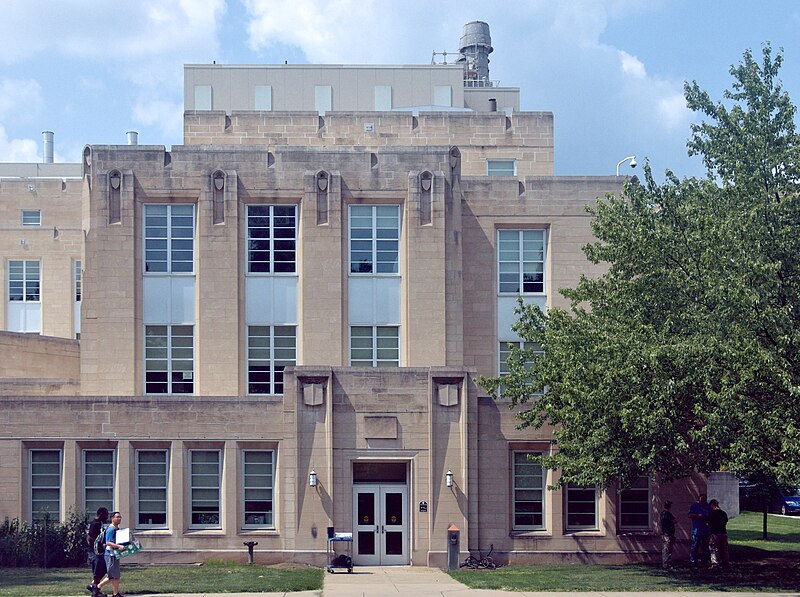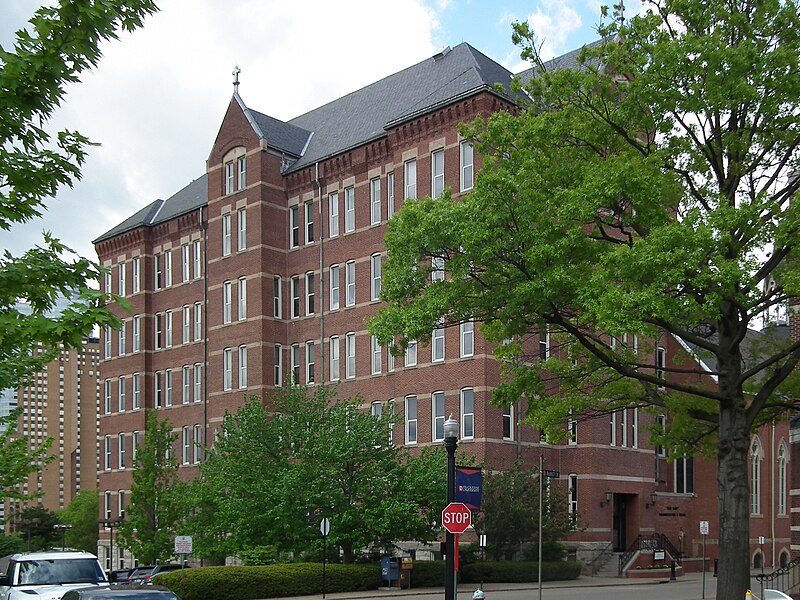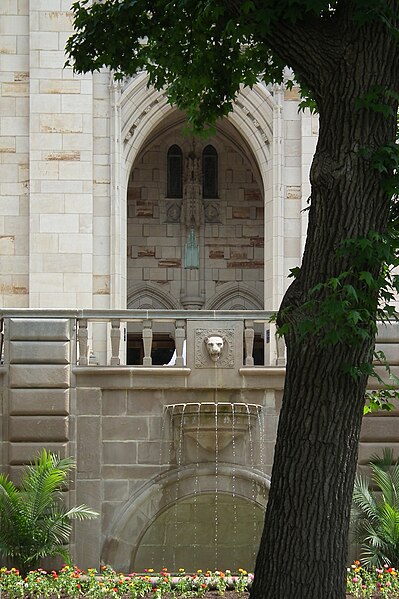
-
Carnegie Mellon University
-
Stairway in Baker Hall, Carnegie Mellon University
-
Some Details of Margaret Morrison Carnegie Hall, Carnegie Mellon University

Of all the buildings on the Carnegie Mellon campus, Margaret Morrison Carnegie Hall (named for Andrew Carnegie’s mother) probably makes the most jaw-dropping first impression. It was originally built in 1907 as a separate but related school, the Margaret Morrison Carnegie School for Women, where women would learn the skills women were fitted to learn. When it was discovered that women were fitted to learn everything, the school dissolved into the larger university.
Henry Hornbostel’s design makes its opening statement with a grand and stripey rotunda that is impressive and welcoming at the same time.


The polychrome ornament found throughout the campus is laid on lavishly here.

One of the sconces in the rotunda.

A side porch with some unusually intricate decoration that nevertheless does not look at all fussy.
-
Nordenberg Hall, University of Pittsburgh

Mark A. Nordenberg Hall, built in 2011, is a perfect example of what old Pa Pitt calls the neoneoclasssical style: it uses the shapes and symmetry of classical architecture without the embarrassing ornamentation. In this building, some of the effect of that missing classical ornamentation is simulated by a pleasing variation in the materials. The architects were the St. Louis firm of Mackey Mitchell Architects, with our own MCF Architecture (the successors to Edward Stotz) coming along for the ride.
This building replaced the 1926 University Place Office Building by Edward B. Lee, a much smaller building that, in its sparse detailing, almost anticipated the neoneoclassical style.
-
Clapp Hall, University of Pittsburgh

In 1956, twenty years after Charles Z. Klauder’s Cathedral of Learning opened, Clapp Hall opened its doors. It was designed by Trautwein & Howard, the successors to Mr. Klauder, but it was no longer possible to make an academic building in the ornate Gothic style that had been Klauder’s specialty. Instead, the architects gave us a restrained late-Art-Deco modernist Gothic that fits well with Klauder’s buildings but doesn’t embarrass postwar sensibilities too badly. The entrance is at an angle to the rest of the building so that the Cathedral of Learning is perfectly framed in the doorway as you walk out.

Below, three views of the Fifth Avenue side:



The Tennyson Avenue side has a similar face:


-
School of Mines Building, University of Pittsburgh

Henry Hornbostel’s drawing of the south façade of the School of Mines Building, later State Hall. It was demolished in 1973 to make way for the Chevron Science Center, and perhaps someone thinks that was an improvement.
This drawing was published in 1909 in The Brickbuilder, an architectural magazine from which we’ll harvest more illustrations in the future.
-
Cathedral of Learning in Postcard Colors
-
Panther Head Fountain at the Cathedral of Learning
-
A Kinder, Gentler Brutalism

Brutalism is the school of modernist architecture that uses raw building materials, especially concrete, as its main aesthetic statement. Father Pitt is not a great lover of the style, but some Brutalist buildings work better than others. The Hillman Library at the University of Pittsburgh has a cool elegance lacking in many other Brutalist buildings. The vertical window bays give us shading that keeps the wall from becoming monotonous, and they also flood the interior with natural light.
It is very hard to explain who designed this building. Wikipedia says, “Design of Hillman Library was led by Celli-Flynn and Associates who served as coordinating architects. Kuhn, Newcomer & Valentour served as associated architects with Harrison & Abramovitz acting as consulting architects to the university. Dolores Miller and Associates consulted on the interior design, and Keyes Metcalf served as a library consultant.”
An architect might be able to sort out the nuances of coordinating, associated, and consulting. Harrison & Abramovitz gave us numerous skyscrapers downtown, but Wikipedia adds that “In 1996, architect Celli-Flynn and Associates and Kuhn, Newcomer & Valentour won the Timeless Award for Enduring Design from the Pittsburgh chapter of the American Institute of Architects for its design of Hillman Library.” This suggests that Harrison & Abramovitz really were consultants rather than responsible for the design; perhaps their role was to say, “No, you can’t do that, or it will fall down.”
Kuhn, Newcomer & Valentour still exists as “DRAW Collective,” based in Mt. Lebanon. Celli-Flynn and Associates was absorbed into Buchart Horn Architects, based in York, but maintaining the staff and office of the Pittsburgh company. It is an interesting commentary on architectural trends that both firms’ recent projects, as displayed on their Web sites, lean toward a timid neoneoclassicism. It does not have the courage to break completely with modernist dogmas and go back to Vitruvius, but neither does it have the daring to invent its own forms and make something new. We get the impression that the clients will be satisfied—but satisfied as in “Yeah, it’s okay,” not satisfied as in “They gave me a masterpiece.”
-
Old Main, Duquesne University, Today and in 1888


A comparison shows that Old Main has gradually been un-Victorianized over the years, losing chimneys and a cupola. The building is still an elegant and commanding presence on campus, though inside there is nothing left on the main floor to indicate that it was built before the twenty-first century. It has been old Pa Pitt’s observation that Catholic universities tend to treat old buildings as embarrassments rather than assets.





